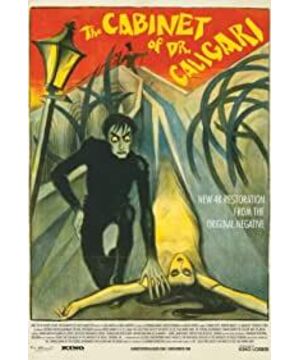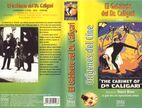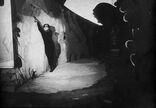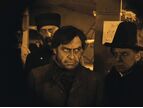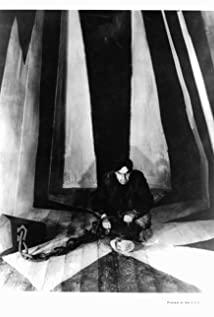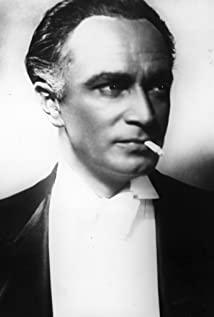*I'd like to choose the seventeenth image as the source of analyzation which will be composed of a brief summary of this image, deeper symbolism and the relationship between the film still and the expressionistic narration.
In this image, I found the lines of the landscape rather bizarre because they are not in their common state through the regular foreshortened technique, which creates a malposition and visual disorder of all figures in the image. The shape of trees are highly distorted while the street lamps seem to be something forcefully inserted there. There's not a leave on the trees and the trees on the right side are bended heavily. With the sharp contrast of the color, my attention was drawn to the withered texture of the film still. The optical effect is obviously strange both in its geometric, stiff form and its pale color. It seems that the light has been transformed from the symbol of illumination into something industrial and formalized.The shadow generally covers more than one half part of the sidewalk and the from of the shadow is transfigured into a sharp, spiral existence. The forms of doctor Caligari and his assistant Caesar are both weirdly disproportionated. Their body, limbs and heads are presented in an inhuman way.
With these details, the whole image successfully delivers a horrible, devastated, alienated hopeless and demon-like atmosphere. The distorted and bald trees in this image is highly identical to the war picture Devastated Landscape near Ypres with Destroyed British Mark IV Tank, 1917. According to one comment of The Cabinet of Dr. Cargari, “the look of the film, which might seem strange to us today, undoubtedly offered more of a déjà vu experience for its European contemporaries still haunted by war and living in a world misshapen by its devastating effect.”1 These distorted trees and limps inevitably work together not only as a symbolism of the distorted mental state of the protagonist, but also as a mirror of the living circumstances deprived of joy and of natural life during the war.The normal life cycles of nature was devastated so both the madman and people at that time felt hopeless towards the “spring”. The light and texture also suggest that they are live in an abnormal world where light no longer serve as spiritual enlightenment but a tool of violent exposure. Such intense, geometric, sharp light only make people want to escape from the whole scene, from the life they were living at that time. The shadow symbolized that there could be no brightness on the madman's way of escaping and then foreshadowed a gloomy future in front of devastated and alienated system of society to a larger extent. Plus, the common sharpness displayed in the image looks like needles that trying to hurt the audience's nerves harshly, which implies that the madman's nerves are terribly hurt.The audience would find the figures unbearable and then understand better the unbearable condition those people faced at that time.
Regarded as a masterpiece of German expressionism, the film tries to express the inner struggle of a madman through explicit pictures. Just as the comment writes about, “the in to convey the distorted viewpoint of a madman: we see the world through the eyes of the protagonist; the film becomes a projection of his vision.” The illness in the picture subtly reflects the mental disorder of this madman and then, this kind of illness could apply to the illness and distortion of the whole society. The director beautifully established his narration by it here in order to show the procedure of escaping from the devastated past, from us just as it haunted the madman in the scene. On this road, the mood of people were as tormented and hopeless as the madman while there was little light shed on their road. This scene exquisitely combines figures, colors,textures, and shadows in an unprecedented way and in both psychoanalysis, historical background and social fields.
View more about The Cabinet of Dr. Caligari reviews


